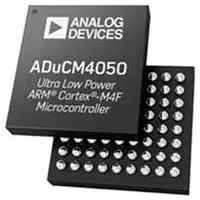 Analog Devices has unveiled an ultra low power microcontroller unit (MCU) that looks to address the growing need for embedding advanced algorithms while consuming the lowest system power at Internet of Things (IoT) edge nodes.
Analog Devices has unveiled an ultra low power microcontroller unit (MCU) that looks to address the growing need for embedding advanced algorithms while consuming the lowest system power at Internet of Things (IoT) edge nodes.
The ADuCM4050 MCU includes an ARM Cortex-M4 core with floating-point unit, expanded SRAM, and embedded flash memory in order to allow localised decision making and ensuring that only the most important data is sent to the cloud.
The MCU uses SensorStrobe technology which allows it to remain in a low power state while sensors and RF technology are still collecting data. As a result the MCU is able to deliver over 10 times system-level power savings resulting in extended battery life or longer time between battery charges.
Security has also been enhanced. Encryption provides stronger IP protection for the designer and better protection against malware and misuse. Among these are AES 128/256, SHA 256, block ciphers for code protection, key wrap, and HMAC.
The ADuCM4050 MCU is to target applications where long battery life is critical, but where security, performance integrity, and the ability to pre-process and filter sensor data to eliminate artifacts and noise are also requirements. Applications include clinical vital-signs monitoring, smart energy management, and asset health/factory equipment reporting.
The ADuCM4050 is able to support multiple digital- and analogue-sensor inputs via its SensorStrobe technology so they can be combined to analyse their data for smarter, more sophisticated functionality and there is no need to wake up the microcontroller frequently to report routine or partial data, saving significant power over the long term.
The extremely low power requirements of the ADuCM4050 are seen in its 40μA/MHz active-mode consumption, which drops to 680nA in hibernate mode. The large amount of SRAM and flash memory – 128kB and 512kB, respectively – and the ability to retain almost all of the SRAM, enables it to get data ready quicker when it wakes up from hibernate (sleep) mode, another major power-saving feature.
Author
Neil Tyler
Source: www.newelectronics.co.uk

